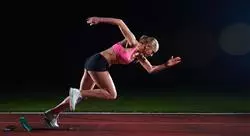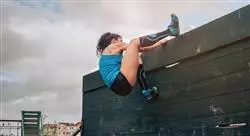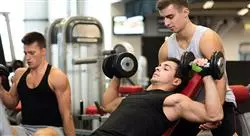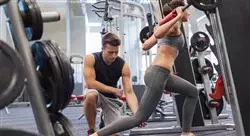Titolo universitario
La più grande facoltà di scienze motorie del mondo"
Presentazione
Espandi la tua presenza nel mondo degli allenamenti personalizzati di alto livello e assisti i tuoi clienti nell'ottimizzazione delle loro capacità fisiche, consentendo loro di raggiungere la massima prestazione corporea”

Gli sport d’élite e alto livello esigono ai professionisti che li praticano uno sforzo fisico superiore rispetti agli altri sportivi. Le loro condizioni fisiche e prestazioni sono altamente esigenti, per cui gli allenatori personali devono avere un’alta conoscenza delle caratteristiche di ogni sport, per raggiungere, attraverso gli allenamenti, la massima prestazione possibile ed evitare lesioni provocate dallo sforzo eccessivo. Per questo motivo, TECH ha progettato questo completo Master specialistico in Allenamento di Forza e Alte Prestazioni Sportive che prevede la partecipazione di un team di insegnanti specializzati con anni di esperienza, che ti permetteranno di svilupparti in questo campo con totali garanzie di successo.
In concreto, questo Master specialistico si divide in due grandi blocchi: da un lato la prestazione sportiva, e dall’altro l’allenamento e la programmazione della forza per la prestazione. Di conseguenza, è una specializzazione innovativa che si occupa in modo aggiornato e approfondito di quelle competenze in materia di prestazioni sportive dal più alto livello in termini di: Fisiologia, Statistica, Nutrizione e Valutazione; così come l’allenamento della forza per migliorare l’espressione della stessa: da come incide questa manifestazione in sport di velocità, resistenza, situazione, fino a come incide in una accelerazione, cambio di direzione, ecc.
Questo Master specialistico, non solo ti presenterà le conoscenze teoriche che offre, ma ti mostrerà anche un altro modo di studiare e imparare, più organico, semplice ed efficiente. Lavoreremo per non farti perdere la motivazione e per creare in te passione per l'apprendimento. Inoltre, ti invoglieremo a pensare e sviluppare il pensiero critico.
Tutto questo con le ultime tecnologie del momento, che ti permetteranno di aggiornarti in maniera comoda e totalmente a distanza, affinché tu sia l’unico che decide dove e quando studiare, con totale facilità di organizzazione e gestione del tuo tempo. In questo modo potrai compaginare facilmente il tuo tempo di studio con il resto degli impegni quotidiani.
Unisciti a TECH e fai la differenza! Avrai accesso a 10 Master class esclusive e dettagliate sulla Prestazione Sportiva, condotte da un rinomato specialista a livello internazionale”
Questo Master specialistico in Allenamento di Forza e Alte Prestazioni Sportive possiede il programma accademico più completo e aggiornato del panorama universitario. Le caratteristiche principali del corso sono:
- Ultima tecnologia nel software di e-learning
- Sistema di insegnamento intensamente visivo, supportato da contenuti grafici e schematici di facile assimilazione e comprensione
- Sviluppo di casi di studio presentati da esperti attivi
- Sistemi di video interattivi di ultima generazione
- Insegnamento supportato dalla telepratica
- Sistemi di aggiornamento e riciclaggio permanente
- Apprendimento autoregolato: piena compatibilità con altri impegni
- Esercizi pratici per l'autovalutazione e la verifica dell'apprendimento
- Gruppi di appoggio e sinergie educative: domande agli esperti, forum di discussione e conoscenza
- Comunicazione con l'insegnante e lavoro di riflessione individuale
- Disponibilità di accesso ai contenuti da qualsiasi dispositivo fisso o portatile con una connessione internet
- Banche di documentazione complementare disponibili permanentemente
Una formazione di alto livello accademico, supportata da un avanzato sviluppo tecnologico e dall'esperienza didattica dei migliori professionisti”
Il personale docente del programma comprende rinomati specialisti del settore e altre aree correlate, che forniscono agli studenti le competenze necessarie a intraprendere un percorso di studio eccellente.
I contenuti multimediali, sviluppati in base alle ultime tecnologie educative, forniranno al professionista un apprendimento coinvolgente e localizzato, ovvero inserito in un contesto reale.
La creazione di questo programma è incentrata sull’Apprendimento Basato su Problemi, mediante il quale lo specialista deve cercare di risolvere le diverse situazioni che gli si presentano durante il corso. Lo studente potrà usufruire di un innovativo sistema di video interattivi creati da esperti di rinomata fama.
Una formazione creata per professionisti che aspirano all'eccellenza e che ti consentirà di acquisire nuove competenze e strategie in modo fluido ed efficace"

Disponiamo della migliore metodologia, di un programma aggiornato e di una moltitudine di casi pratici che ti aiuteranno a prepararti per il successo"
Obiettivi e competenze
L'obiettivo principale di TECH per questo Master specialistico è fornire informazioni aggiornate ed efficaci sulle diverse tecniche e procedure degli allenamenti di forza e delle prestazioni sportive di alto livello. Si tratta di una serie di obiettivi che lo studente potrà raggiungere man mano che avanza nel programma, il che porterà a beneficiare del suo livello di professionalità al termine della qualifica, in linea con gli sviluppi delle scienze dello sport.

Se il tuo obiettivo è quello di acquisire una qualifica che ti abiliti a competere tra i migliori, non cercare oltre: in TECH abbiamo tutto ciò di cui hai bisogno”
Obiettivi generali
- Padroneggiare e applicare con certezza i metodi di allenamento più attuali per migliorare la prestazione sportiva
- Padroneggiare con efficacia la statistica e fare un corretto uso dei dati ottenuti dall’atleta, oltre a iniziare processi di ricerca
- Acquisire conoscenze basate sull’evidenza scientifica più attuale con totale applicabilità nel campo pratico
- Padroneggiare tutti i metodi più avanzati per la valutazione della prestazione sportiva
- Padroneggiare i principi su cui si basano la Fisiologia dell’Esercizio e la Biochimica
- Padroneggiare i principi su cui si basa la Biomeccanica applicata direttamente alla prestazione sportiva
- Padroneggiare i principi su cui si basa la Nutrizione applicata alla prestazione sportiva
- Integrare con successo alla pratica reale tutte le conoscenze acquisite nei vari moduli
- Approfondire le conoscenze basate sulle prove scientifiche più attuali con piena applicabilità nel campo pratico dell'allenamento della forza
- Padroneggiare tutti i metodi più avanzati in quanto all’allenamento della forza
- Applicare con certezza i metodi di allenamento più attuali per migliorare la prestazione sportiva relazionata con la forza
- Padroneggiare con efficacia l’allenamento della forza per migliorare la prestazione negli sport a tempo e di situazione
- Padroneggiare i principi su cui si basano la Fisiologia dell’Esercizio e la Biochimica
- Approfondire i principi che reggono la Teoria dei Sistemi Dinamici Complessi a cui si riferisce l’allenamento della forza
- Integrare con successo l’allenamento della forza per migliorare le abilità motorie immerse nello sport
- Padroneggiare con successo nella pratica reale tutte le conoscenze acquisite nei vari moduli
Obiettivi specifici
Modulo 1. Fisiologia dell'esercizio e attività fisica
- Approfondire le vie metaboliche energetiche e le loro modificazioni indotte dall'esercizio fisico, oltre al loro ruolo nel rendimento umano
- Gestire gli aspetti chiave del sistema neuromuscolare, il controllo motorio e il loro impatto sull'allenamento fisico
- Approfondire la fisiologia muscolare, il processo di contrazione muscolare e le basi molecolari di questi fenomeni
- Interpretare le cause generali della fatica e il loro impatto su diversi tipi e modalità di esercizio
- Analizzare e applicare i vari traguardi fisiologici nella pratica quotidiana
Modulo 2. Statistica applicata alla Prestazione e alla Ricerca
- Potenziare la capacità di analisi dei dati raccolti sia in laboratorio che sul campo, mediante vari strumenti di valutazione
- Descrivere i diversi tipi di analisi statistica e la loro applicazione in varie situazioni per comprendere i fenomeni che si verificano durante l'allenamento
- Sviluppare strategie per l'esplorazione dei dati al fine di determinare i migliori modelli per la loro descrizione
- Definire le generalità dei modelli predittivi attraverso analisi di regressione che facilitino l'integrazione di diverse unità di analisi nel campo dell'allenamento
- Creare le condizioni per una corretta interpretazione dei risultati in diversi tipi di ricerca
Modulo 3. Allenamento della Forza dalla Teoria alla Pratica
- Interpretare correttamente tutti gli aspetti teorici che definiscono la forza e i suoi componenti
- Padroneggiare i metodi di allenamento della forza più efficaci
- Sviluppare il criterio necessario per poter sostenere la scelta di diversi metodi di allenamento nell'applicazione pratica
- Determinare obiettivamente le necessità di forza di ciascun atleta
- Padroneggiare gli aspetti teorico-pratici che definiscono lo sviluppo della potenza
- Applicare correttamente l'allenamento della forza nella prevenzione e nella riabilitazione delle lesioni
Modulo 4. Allenamento della Velocità dalla Teoria alla Pratica
- Interpretare gli aspetti chiave della tecnica di velocità e del cambio di direzione
- Confrontare e differenziare la velocità negli sport di situazione rispetto al modello dell'atletismo
- Incorporare criteri di osservazione tecnica che permettano di identificare errori nella meccanica di corsa e le procedure per la loro correzione
- Approfondire gli aspetti bioenergetici degli sprint singoli e ripetuti e come si relazionano con i processi di allenamento
- Distinguere quali sono gli aspetti meccanici che possono influenzare la diminuzione del rendimento e i meccanismi di produzione di lesioni nello sprint
- Applicare in modo analitico i diversi mezzi e metodi di allenamento per lo sviluppo delle diverse fasi della velocità
- Programmare l'allenamento della velocità negli sport di situazione
Modulo 5. Allenamento della Resistenza dalla Teoria alla Pratica
- Approfondire le diverse adattamenti indotti dall'allenamento aerobico sulla resistenza
- Applicare le richieste fisiche degli sport in situazione
- Selezionare i test più appropriati per valutare, monitorare, tabulare e frazionare i carichi di lavoro aerobico
- Sviluppare i diversi metodi per organizzare gli allenamenti
- Progettare allenamenti tenendo conto delle specificità dello sport praticato
Modulo 6. Mobilità dalla Teoria al Rendimento
- Trattare la mobilità come una capacità fisica fondamentale da una prospettiva neurofisiologica
- Approfondire i principi neurofisiologici che influenzano lo sviluppo della mobilità
- Applicare i sistemi stabilizzatori e mobilizzatori all'interno del pattern di movimento
- Dettagliare e specificare i concetti base e gli obiettivi associati all'allenamento della mobilità
- Sviluppare la capacità di progettare compiti e piani per lo sviluppo delle manifestazioni della mobilità
- Impiegare diversi metodi per ottimizzare il rendimento attraverso i metodi di recupero
- Sviluppare la capacità di eseguire una valutazione funzionale e neuromuscolare dell'atleta
- Riconoscere e affrontare gli effetti prodotti da una lesione a livello neuromuscolare nell'atleta
Modulo 7. Valutazione delle Prestazioni Sportive
- Approfondire i diversi tipi di valutazione e la loro applicabilità al campo pratico
- Selezionare i test più appropriati in base alle specifiche esigenze
- Gestire in modo corretto e sicuro i protocolli dei vari test e l'interpretazione dei dati raccolti
- Applicare diverse tecnologie attualmente utilizzate nel campo della valutazione dell'esercizio, sia nel contesto della salute che del rendimento della fitness a ogni livello di esigenza
Modulo 8. Pianificazione Applicata alla Prestazione Sportiva di Alto Livello
- Comprendere la logica interna della pianificazione e i suoi modelli centrali
- Applicare nel training il concetto di dosaggio-risposta
- Distinguere chiaramente l'impatto della programmazione rispetto alla pianificazione e alle loro interdipendenze
- Acquisire la capacità di progettare diversi modelli di pianificazione adeguati alla realtà lavorativa
- Applicare i concetti appresi in un design di pianificazione annuale e/o pluriennale
Modulo 9. Biomeccanica Applicata alla Prestazione Sportiva di Alto Livello
- Specializzarsi nei principi della Biomeccanica orientata all'educazione fisica e allo sport
- Applicare le conoscenze e le tecnologie di base della biomeccanica in funzione dell'educazione fisica, dello sport, del rendimento e della vita quotidiana
- Valutare l'importanza dei protocolli e dei diversi tipi di valutazione biomeccanica come fattore fondamentale nel processo di sviluppo e valutazione sportiva
- Sviluppare un pensiero critico e analitico che consenta di generare protocolli e procedure innovativi, utilizzando diversi tipi di tecnologia
Modulo 10. Nutrizione Applicata alla Prestazione Sportiva di Alto Livello
- Studiare le basi fisiologiche e biochimiche del metabolismo energetico associato allo sforzo fisico
- Conoscere i processi e i metodi per la valutazione nutrizionale dell'atleta e la sua composizione corporea
- Apprendere le diverse opzioni per la valutazione del dispendio energetico dell'atleta
- Esplorare tutte le variabili relative alla nutrizione in discipline sportive di caratteristiche molto diverse
- Interpretare le ultime evidenze scientifiche riguardanti la supplementazione sportiva
- Gestire gli aspetti nutrizionali associati ai disturbi alimentari e alle lesioni sportive
Modulo 11. Allenamento della Forza per il Miglioramento delle Abilità di Movimento
- Interpretare gli aspetti chiave della biochimica e della termodinamica
- Approfondire il funzionamento dei sistemi cardiovascolare e respiratorio e l'utilizzo dell'ossigeno durante l'esercizio
- Gestire le cause generali della fatica e il loro impatto su diversi tipi e modalità di esercizio
- Identificare i diversi traguardi fisiologici e la loro applicazione pratica
Modulo 12. Allenamento della Forza sotto il Paradigma dei Sistemi Dinamici Complessi
- Approfondire la relazione tra la forza e le abilità specifiche (skills)
- Identificare le principali abilità nei diversi sport per poterle analizzare, comprenderle e successivamente potenziarle attraverso l'allenamento
- Organizzare e sistematizzare il processo di sviluppo delle abilità
- Collegare e correlare gli allenamenti in campo e in palestra per ottimizzare lo sviluppo delle abilità
Modulo 13. Prescrizione e Programmazione dell'Allenamento della Forza
- Gestire conoscenze specifiche sulla teoria dei sistemi nel training sportivo
- Analizzare i diversi componenti che si interrelazionano nell'allenamento della forza e la loro applicazione negli sport di situazione
- Orientare le metodologie di allenamento della forza verso una prospettiva che risponda alle esigenze specifiche dello sport
- Sviluppare una visione critica sulla realtà dell'allenamento della forza per popolazioni sportive e non sportive
Modulo 14. Metodologia dell'Allenamento della Forza
- Interpretare gli aspetti chiave dell'allenamento della forza
- Approfondire i diversi componenti del carico di lavoro
- Profondizzare in aspetti cruciali delle pianificazioni, della periodizzazione e del monitoraggio del carico
- Conoscere in dettaglio i diversi schemi di strutturazione delle sessioni di allenamento
- Gestire i modelli più comuni di prescrizione, monitoraggio e adeguamento
Modulo 15. Teoria dell'Allenamento della Forza e Basi per l'Allenamento Strutturale
- Approfondire le diverse proposte metodologiche dell'allenamento della forza e la loro applicabilità al campo pratico
- Selezionare i metodi più appropriati alle esigenze specifiche
- Riconoscere e applicare con sicurezza i diversi metodi proposti nella letteratura di riferimento
Modulo 16. Allenamento della Forza per il Miglioramento della Velocità
- Padroneggiare in profondità i termini teorici relativi all'Allenamento della Forza
- Padroneggiare in profondità i termini teorici relativi all'Allenamento della Potenza
- Dominare con criterio gli aspetti metodologici dell'Allenamento con finalità Ipertrofiche
- Dominare con criterio gli aspetti Fisiologici dell'Allenamento con finalità Ipertrofiche
Modulo 17. Valutazione delle Prestazioni Sportive nell'Allenamento della Forza
- Conoscere e interpretare gli aspetti chiave della tecnica della velocità e del cambio di direzione
- Confrontare e differenziare la velocità negli sport di situazione rispetto al modello dell'atletismo
- Approfondire gli aspetti meccanici che possono influenzare la diminuzione di rendimento e i meccanismi di produzione di lesioni nello sprint
- Applicare analiticamente i diversi mezzi e metodi di allenamento della forza per lo sviluppo dello sprint
Modulo 18. Allenamento della Forza negli Sport di Situazione
- Approfondire la logica di progettazione degli allenamenti basati sul movimento
- Differenziare mezzi e metodi per l'allenamento della forza
- Rilevare i pattern di movimento prioritari per l'applicazione della forza nello sport specifico
- Capire il funzionamento e l'applicazione delle tecnologie al servizio dell'allenamento della forza
Modulo 19. Allenamento negli Sport di Media e Lunga Durata
- Approfondire la logica di progettazione degli allenamenti basati sul movimento
- Differenziare i mezzi e i metodi per l'allenamento della forza
- Rilevare i pattern di movimento prioritari per l'applicazione della forza nello sport di riferimento
- Capire il funzionamento e l'applicazione delle tecnologie al servizio dell'allenamento della forza

Ti offriamo una specializzazione di alto livello per soddisfare il nostro obiettivo di eccellenza accademica, ma, soprattutto, per aiutarti a competere con i migliori"
Grand Master in Allenamento della Forza e Alto Rendimento Sportivo
Nello sport, la gloria dei campioni è forgiata con il fuoco dei muscoli e l'acciaio immobile che simboleggia la volontà. L'allenamento è la fucina. E solo coloro che trasmutano il loro sudore in destrezza fisica hanno il potere di accedere al podio. È necessario, logicamente, avere una consulenza professionale con le conoscenze adeguate. In questa direzione si colloca il Grand Master in Allenamento della Forza e Alto Rendimento Sportivo offerto da TECH Università Tecnologica, una proposta notevole di significativo raggio accademico che funge da complemento alle diverse discipline e branche che comprendono l'educazione fisica o le scienze dello sport. Attraverso lezioni completamente virtuali che facilitano la gestione degli orari secondo le esigenze personali, potrai raggiungere un nuovo traguardo nella tua ascesa professionale reindirizzando le tue possibilità lavorative verso ambiti d'élite. Con la disamina di dieci moduli tematici, rafforzerai le tue competenze e ne aggiungerai altre nuove, essendo testimone del perché siamo l'università online numero uno al mondo.
Allenamento fisico per l'alto rendimento, un Grand Master infallibile
Può lo sport trarre vantaggio in modo proficuo dalle conoscenze scientifiche? La risposta è più che ovvia, ma basta solo dare un'occhiata al nostro consolidato programma per vedere le potenzialità latenti in questa sinergia, fisiologia dell'esercizio e attività fisica, statistica applicata al rendimento e ricerca, nutrizione focalizzata sull'alto rendimento sportivo, allenamento della forza e della velocità. Questi sono alcuni dei concetti che compongono il curriculum del nostro post-laurea, ciascuno spiegato in dettaglio da un team di docenti con una vasta esperienza nel settore. Aspiri a diventare una figura di rilievo in una palestra internazionale o a trasformarti nell'allenatore del prossimo Messi o della prossima Serena Williams? Scegli questo plus che ti offre TECH e impara secondo gli standard più rigorosi del settore accademico e sportivo senza uscire di casa e persino, combinando questa formazione con altre attività di tuo interesse. Scopri la libertà di imparare e andare lontano iscrivendoti a TECH.







